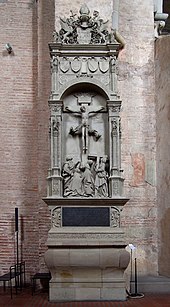Richard von Greiffenklau zu Vollrads
Richard von Greiffenklau zu Vollrads (* 1467 in Vollrads Castle near Oestrich-Winkel , † March 13, 1531 in Ottenstein Castle near Wittlich ) was Archbishop and Elector of Trier from 1511 to 1531.
family
Richard came from the Rheingau noble family Greiffenklau and was the fourth son of the vice dome of the Rheingau Johann von Greiffenklau zu Vollrads and Klara von Ratsamhausen. The grandfather Friedrich von Greiffenclau zu Vollrads (1401–1462) became a Franciscan in 1456 after a pilgrimage to the Holy Land . His sister Isengart von Greiffenclau zu Vollrads was a nun in the Marienberg monastery in Boppard , is considered his reformer and died there in 1469, with a reputation for holiness. Richard's cousins were the famous Bishop of Worms and Chancellor of the Electoral Palatinate, Johann XX. von Dalberg , as well as his brothers Friedrich VI. von Dalberg , Mayor and Wolfgang VI. von Dalberg (1473–1522), Electoral Palatinate bailiff in Oppenheim .
Life
Richard von Greiffenclau decided early on to pursue a career in the church. After five years of training, he became Cathedral Chapter in Trier in 1487 . From 1488 he studied in Paris . In 1503 he was appointed cantor in Trier Cathedral and became a canon in Mainz . On May 15, 1511 Richard was appointed Archbishop of Trier. The inauguration took place on May 30, 1512 by Uriel von Gemmingen , the archbishop of Mainz , in the presence of the bishops of Strasbourg and Worms . Before that, on April 26th, the Capitular Jakob von Eltz had delivered the confirmation bull of Pope Julius II and the pallium . Associated with the Trier bishopric was the electoral dignity .
Reign
At the request of Emperor Maximilian I , Richard had the holy skirt displayed for 23 days after taking office as elector . Also in 1512 he had the south-west tower of the cathedral increased because the tower of the parish church of St. Gangolf towered over the cathedral towers. In 1515 he reformed the judiciary and ordered that displaced Jews be allowed back into the country.
Richard regularly attended sessions of the Reichstag . When the new German emperor was elected in Frankfurt in 1519 , he sided with Francis I of France after receiving bribes . However, Charles V was elected. At the Diet of Worms (1521) , Archbishop Martin Luther urged him to revoke his Reformation views and even offered him protection and accommodation in Kurtrier; but Luther did not accept the offer.

Kurtrier remained largely unaffected by the Reformation . Only the knight Franz von Sickingen caused greater problems for Richard . As a supporter of supporters of the Reformation, he was an opponent of the Trier Elector, who acted against Luther. Sickingen tried to conquer the city of Trier in autumn 1522 , but this failed. In the spring of 1523 Richard took part in the counter-campaign of the prince coalition (apart from Trier also Electoral Palatinate and Hesse ) against Sickingen, which ended with his defeat and death.
Richard expanded the castle on the Ehrenbreitstein into a fortress. In 1524 he had Master Simon from Frankfurt cast the 9-ton, 4.5-meter long cannon “Greif” and set it up on the fortress. It was the largest siege cannon of its time.
At the Diet of Speyer in 1529 Richard took in part, but a year later in Augsburg was he - probably due to illness - represented by its eventual successor, the former provost John III. from Metzenhausen . 1531 died Richard and found his final resting place in front of a magnificent Renaissance - Epitaph in Trier Cathedral.
literature
- Max Bär : Richard von Greifenklau zu Vollraths . In: Allgemeine Deutsche Biographie (ADB). Volume 28, Duncker & Humblot, Leipzig 1889, pp. 413-418.
- Florian Gläser: Richard von Greiffenclau on Vollrads. In: New German Biography (NDB). Volume 21, Duncker & Humblot, Berlin 2003, ISBN 3-428-11202-4 , p. 507 f. ( Digitized version ).
- Martin Persch : Richard von Greiffenklau on Vollrads. In: Biographisch-Bibliographisches Kirchenlexikon (BBKL). Volume 8, Bautz, Herzberg 1994, ISBN 3-88309-053-0 , Sp. 208-211.
Web links
Individual evidence
- ^ Genealogical website about Johann von Greiffenclau
- ↑ Website on the epitaph of Isengart von Greiffenclau zu Vollrads
- ^ Genealogical website on Friedrich von Greiffenclau
| predecessor | Office | successor |
|---|---|---|
| Jacob II of Baden |
Elector Archbishop of Trier 1511–1531 |
Johann III. from Metzenhausen |
| personal data | |
|---|---|
| SURNAME | Greiffenklau zu Vollrads, Richard von |
| ALTERNATIVE NAMES | Greiffenclau zu Vollrads, Richard von; Greifenklau zu Vollraths, Richard von |
| BRIEF DESCRIPTION | Archbishop and Elector of Trier |
| DATE OF BIRTH | 1467 |
| PLACE OF BIRTH | Vollrads Castle |
| DATE OF DEATH | March 13, 1531 |
| Place of death | Ottenstein Castle |

